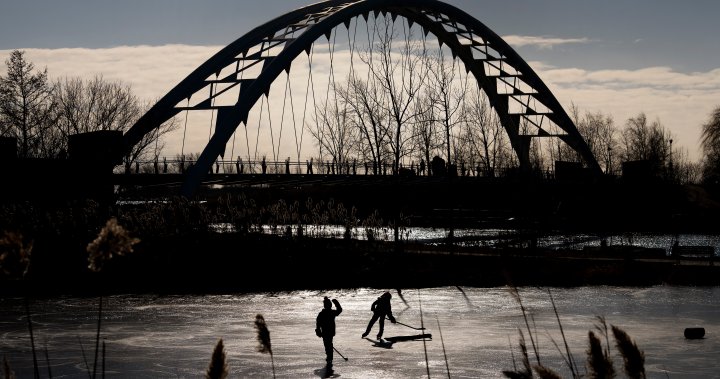As the winter cold begins to settle in, many Canadians will look to take up seasonal activities like ice skating.
Many rinks and ice surfaces across the country are already in operation, but the latest cold snap could bring skaters to rivers, lakes and ponds.
However, ice can be deceiving, and if you take to those natural bodies without checking to see how frozen they are, you will put yourself at risk, said Stephanie Bakalar, corporate communications manager for Lifesaving Society Ontario, an organization promoting water safety.
“With temperatures fluctuating the way they have been recently, we need people to be extra cautious,” she told Global News.
“No ice is safe ice.”
Extreme cold has ushered in the start of the new year in many parts of the nation.
Western Canada has dealt was days of deep freeze, with temperatures feeling like -50 C with the wind chill in some parts.
Environment Canada forecasts on Monday for Toronto and Ottawa had both major Ontario cities experiencing lows in the double digits with wind chill for the entire week; forecasts were similar in Montreal and Quebec City.
While the cold weather may be a sign ice is starting to form, you won’t know until you check, Bakalar said.
“It looks frozen, but you really don’t know what’s under that little bit that you see on the surface until you actually cut a hole in the ice and see what’s going on under there,” she said.
Get the latest Health IQ news.
Sent to your email, every week.
“We really need people to realize that ice can be deceiving.”
Last month, at least six Canadians died in less than a week after falling into icy bodies of water; two of those victims were teenagers in Ottawa, whose bodies were pulled from the Rideau River.
Meanwhile, a 61-year-old man west of Calgary died Christmas Day, after falling into the Bow River.
A spokesperson for Toronto police told Global News last year it received 10 calls for people on unsafe ice, with one major call being on Feb. 6, 2023., in the city’s harbour on Lake Ontario.
“Three people fell through the ice when skating in the harbour,” they said.
“The Marine Unit responded immediately and pulled them out safely. The lake only started to freeze up that same day.”
Before taking to the ice, Bakalar said you should be prepared: don’t take to the ice alone; bring a rope; and have someone ashore ready to help in case things go wrong.
Don’t venture too far onto the ice, she said, adding that you should be wearing a floatation device in case the ice breaks.
“You want to take your auger, which is a device that cuts a hole through the ice (and) dig a hole through the ice,” Bakalar said.
“Pull up some ice and check the quality. Is it mushy, or is there water in there? And you’re also going to want to check for the thickness.”
Alberta RCMP Const. Kelsey Davidge told Global News recently people should pay attention to the colour of the ice, which may be an “indication of its strength,” with clear blue to black being the deepest.
Bakalar said the ice should be at least four inches thick, but that measurement is for one person only. The more people there are on the ice, the thicker it has to be, she added.
If you fall through the ice, the first thing you will experience is cold water shock, Bakalar said.
“You’re going to gasp and it’s going to be very difficult for you to take a nice big breath and for you to breathe properly. You need to try to calm your breathing as best you can. You want to go into a huddle position into a little ball and you’re going to scream for help,” she said.
“Climbing out of the ice is going to be incredibly difficult. The more weight that goes onto the ice, the more likely the ice underneath you is to break. The only way to get out of ice is to actually shimmy on your belly. It is extremely difficult, and it can be extremely exhausting for someone who is in the water.”
Bakalar added if you witness someone who falls into the ice, call 911.
“You do not want to become a victim yourself. The best thing that you can do is call for help,” she said.
“If you are on dry land and you can throw something that floats to the person that’s gone through the ice, or something that you can lie down on your stomach, reach out to them and actually try to pull them in while you stay on dry, safe land. You could do that as well.”
— with files from Global News’ Touria Izri
© 2024 Global News, a division of Corus Entertainment Inc.


